#paleontologist
Text
The Lancetfish is a species that looks like it comes straight out of a realistic fantasy world building project.
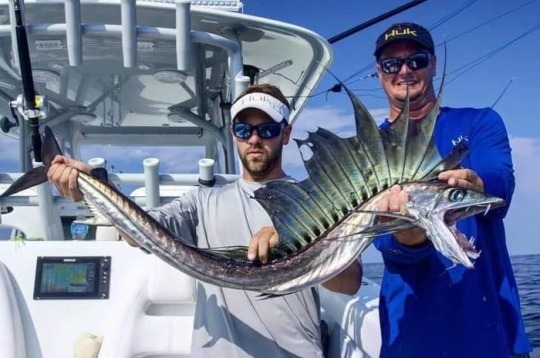
#speculative biology#speculative ecology#speculative evolution#speculative zoology#traditional art#traditional sketch#spectember#specposium#paleontology#fanart#paleo meme#paleo art#paleontologist#paleostream#paleobird#paleomedia#paleoblr#paleoillustration#paleoart#worldbuilding#world#fishing#world building#fantasy#realistic fantasy#fish#lancet fish#lancetfish
65K notes
·
View notes
Text

The fossil is not the animal.
The fossil is not the bones of the animal.
The fossil is the stone's memory of the bones of the animal.
And that's a poetry older than words.
🩶🦕🦖🩶
#paleontologist#paleontology#dinosaur fossil#dinosaur fossils#dinosaur bones#prehistoric#Jurassic Park#Jurassic World#jurassic park anniversary#jurassic park 3d#jurassic park 30th anniversary
4K notes
·
View notes
Text

1K notes
·
View notes
Text
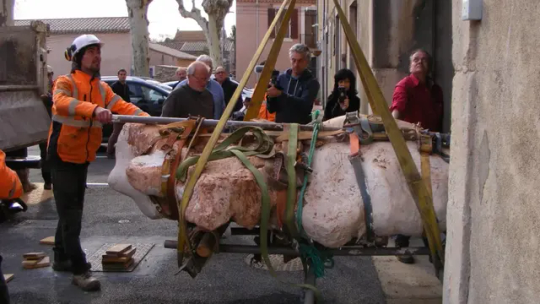
A 70 Million-Year-Old Titanosaur Dinosaur Skeleton Found in France
A chance discovery made in southern France has revealed a rare specimen — an almost complete dinosaur skeleton found connected from its hind skull to its tail.
The massive fossil came to light in May 2022, after now 25-year-old amateur paleontologist Damien Boschetto and his dog stumbled across something unusual while walking in a forest in Montouliers, France. Boschetto had noticed a cliff edge that had recently collapsed and decided to take a closer look, when he spotted an exposed bone sticking out of the ground, local media outlet France Bleu first reported on February 13.
The Archaeological and Paleontological Cultural Association at the Cruzy Museum, in collaboration with the French National Center for Scientific Research, identified the nearly 10-meter-long (32.8-foot-long) fossil as a Titanosaur skeleton upon excavation. Boschetto, who has been a member of the association for eight years, said that while unearthing dinosaur remains is “always exciting and interesting for scientific research and the understanding of the ecosystems of that time,” finding the bones in their almost original anatomical position is what makes this find extraordinary.
“From a museography point of view, it will make it possible to present to the general public animals almost complete in anatomical positions, which is something great,” Boschetto added via email.
A group of history and archaeology enthusiasts created the Archaeological and Paleontological Cultural Association in 1975 to safeguard the heritage around the village of Cruzy, with several members becoming enlightened amateurs in paleontology due to the areas’ wealth of dinosaur fossils, said Jean-Marc Veyssières, a member of the group and one of the fossil preparers for this discovery. Today, the association is made up of inhabitants of the region, including a few scientists as well as students.
“The most exciting thing was to realize that we had at least one anatomically connected animal and that it was a titanosaur, a long-necked dinosaur,” said Veyssières in an email. “(Boschetto) is an enlightened enthusiast and curious about nature, he spends a lot of time surveying the region in search of new areas. … He became an expert on the Late Cretaceous fauna of our region.”
The association has been excavating the site, which Boschetto referred to as a bone bed, a term used by paleontologists to describe a dense area of animal bones and other fossilized remains, for the past two years. And the newly announced find was not Boschetto’s first.
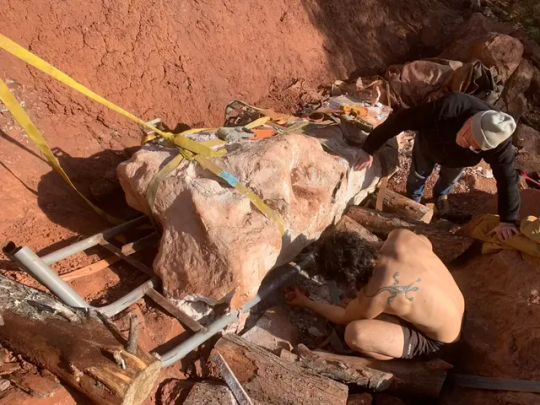
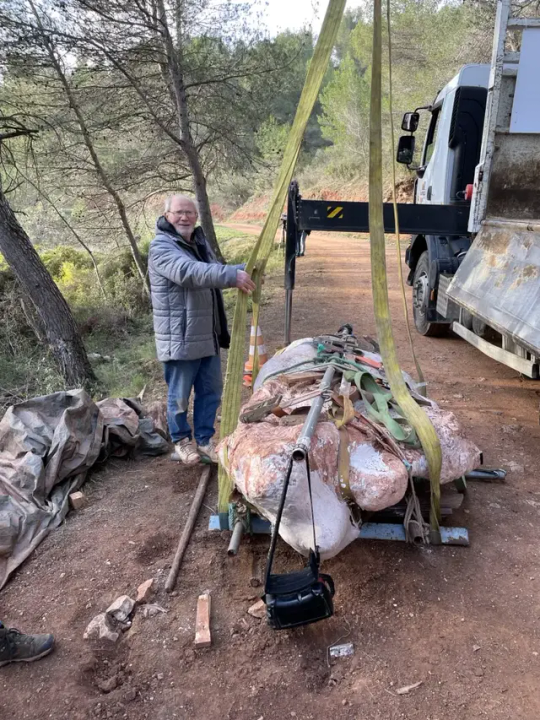
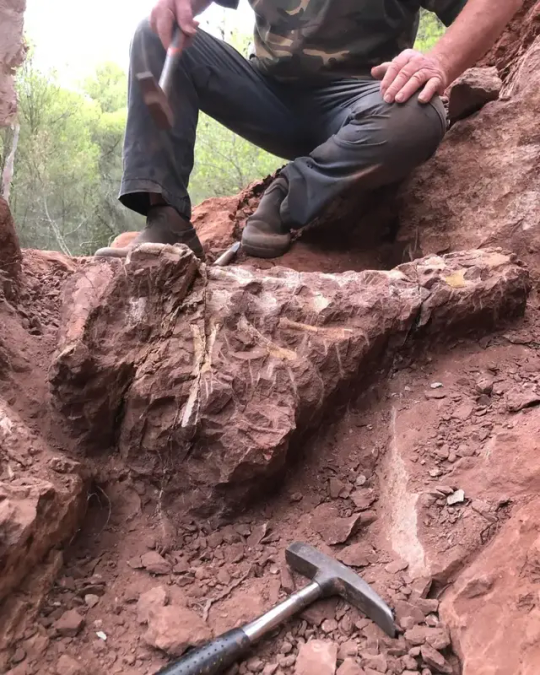
The recently revealed 70% complete Titanosaur skeleton was retrieved during the excavation along with several fossils of various dinosaurs and other vertebrates, including some in anatomical connection and near complete. Other remains identified included those of a Rhabdodon — a herbivore, or plant-eater, like the Titanosaur — and fragments from skeletons of carnivores such as Theropods and crocodiles, according to Boschetto.
The Titanosaur skeleton currently resides in the Cruzy Museum’s laboratory, where it will be further studied, Veyssières said.
Titanosaur found intact
Researchers estimated the age of the newly discovered fossil to be around 70 to 72 million years old, but Titanosaurs roamed around on four legs from the Late Jurassic Epoch to the end of the Cretaceous Period, approximately 163.5 million to 66 million years ago. Titanosaurs belong to a larger group of dinosaurs known as sauropods, a family of long-necked herbivores that were some of the largest dinosaurs of their time, according to Britannica.
Remains of Titanosaur fossils are widely unearthed in Europe, but few are discovered in anatomical connection, Boschetto said. Finding a skeleton in this connected state suggests that the body was buried before it had entirely decomposed, leaving “some tissues connecting the bones to one another,” said Matthew Carrano, research geologist and curator of Dinosauria at the Smithsonian Institution National Museum of Natural History.


The completeness of the specimen will “make it easier to determine whether it’s a new species or a new specimen of a species that’s already known,” Carrano said in an email. “It will take time to learn all the details about this new specimen, but I’m sure it will provide important new information about this group of dinosaurs.”
The region in which Boschetto discovered the specimen is known to be rich in fossils of dinosaurs and other species living at the same time and is “building one of the largest collections of dinosaurs from the Upper Cretaceous in France,” he said. The association did not publicize the discovery until excavation was complete to protect the archaeological site, he added.
The association plans to continue research on the fossils and to further search the area, and the group’s members hope to obtain the funds to “create a large-scale museum that can accommodate and present these collections,” Boschetto said.
By Taylor Nicioli.
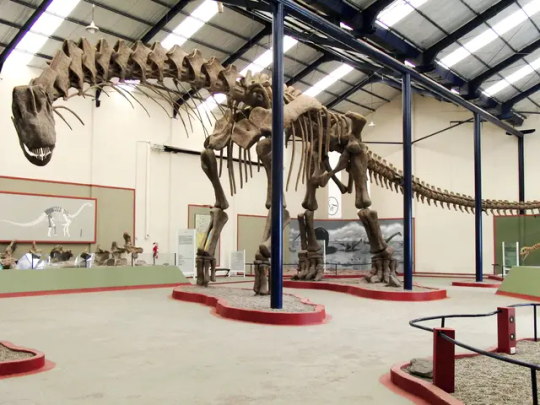


#A 70 Million-Year-Old Titanosaur Dinosaur Skeleton Found in France#Montouliers France#paleontologist#dinosaurs#fossils#ancient artifacts#archeology#archeolgst#history#history news#ancient history
380 notes
·
View notes
Text


thinking about pvz immensely again
#my art#plants vs zombies#pvz#sunflower#pvz sunflower#super brainz#80s action hero#pvz 80s action hero#space cadet#pvz space cadet#paleontologist#pvz paleontologist#traditional art#sketches
59 notes
·
View notes
Note
As a former human child I’ve always wanted to know: how exactly does one become a paleontologist?
okay there are lots of ways. this is my way
have parents that, while poor, value education and learning
have significantly older siblings that do not care about appropriateness for children in terms of television content
bc of b, see jurassic park as an infant
bc of that, and land before time, fall in love with dinosaurs
be neurodivergent
become OBSESSED with dinosaurs
bc of a, have parents encourage this and rent me all the documentaries
learn everything about dinosaurs
when asked "why do you like them" at age 5, answer "because their evolution is cool"
survive elementary school
survive middle school
do a lot of science stuff in school
do science competitions in high school
remain obsessed with dinosaurs/birds and other reptiles and prehistoric life
survive high school
go to college
major in biology
do research in evolution and the cambrian explosion
graduate
go to graduate school to become an evolutionary developmental biologist because your parents wanted you to do genetics bc they thought it had a better chance of me getting a job
be miserable during that program
only derive joy from docenting at the field museum and going to dino science conferences
cut out with a masters' when you realize you can't take it anymore
ponder being a rabbi for a while bc maybe you're not cut out for science
go to a dino conference online and actually network with a paleontologist who wants students
interview with him and find he has a lot of research interests in common with you
apply to the school, get accepted
move across the fucking country (chicago -> new mexico)
work hard because this is your second chance and you have *meds* now
help describe a bird in the first year
have a really holistic and ambitious thesis project idea
paleontologist now, I guess
#paleontologist#how to be a paleontologist#science#paleontologist ama#i was privileged in the parents I had in that they encouraged my curiosity. not everyone gets that.
219 notes
·
View notes
Text
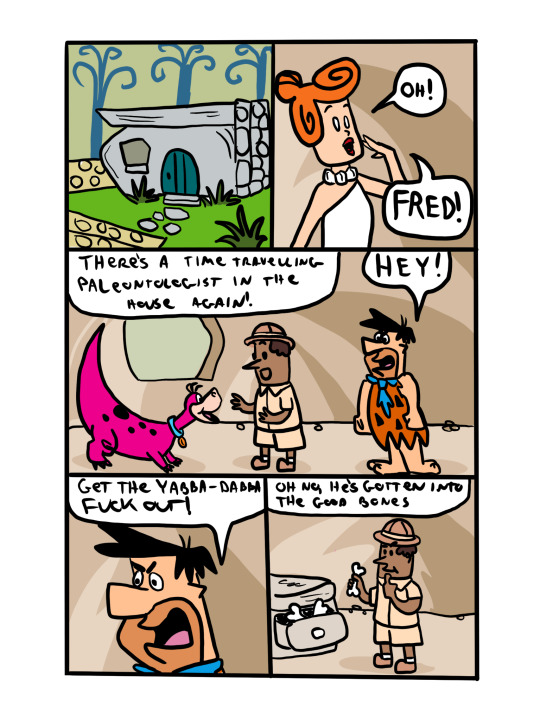
I had a dream about a time traveling paleontologist visiting the Flintstones. This is only the first part
89 notes
·
View notes
Text

New York Eurypterid
37 notes
·
View notes
Text
It's prehistoric creature nerd hours so I'm here to talk abt my favorite prehistoric marine reptile:
THE ELASMOSAURUS
This post was originally a google doc I wrote about the Elasmosaurus, all sources can be found at the bottom :]

Who was the Elasmosaurus?
The Elasmosaurus is, as stated before, a marine reptile and not a dinosaur. It is one of the most well known plesiosaurs in the world, and is notable for its extremely long neck. Elasmosaurus lived in the late cretaceous period, and had a diet consisting of small fish and marine invertebrates (piscivore). I find the elasmosaurus to be particularly interesting because of its physical attributes and its complicated discovery.
Elasmosaurus is part of the genus Elasmosauridae. This genus is best known for their remarkably long necks, longer than most plesiosaurs. The elasmosaurus had the second most neck vertebrae of any other creature to ever live on earth, and had a whopping 72 vertebrae. This is only 4 less vertebrae than the Albertonectes (an extinct plesiosaur related to the Elasmosaurus.) Its neck measures in at about 23 feet long (7.1 meters), and its entire body, head to tail, measures in at about 45 feet (14 meters), and weighed 8-10 tons. When the Elasmosaurus was first being studied and reconstructed, it was thought that it could coil its neck like a snake and had lots of flexibility. Some scientists even speculated that in order to hunt, the Elasmosaurus could extend its long neck above the water and look for fish below, but these theories have since been disproven. The neck of the elasmosaurus would have been held quite straight with little movement up and down, but this was actually a key part of its hunting method. The Elasmosaurus most likely would swim up to a school of fish, hiding itself in the darker parts of the water. It used its long neck to grab the fish in its mouth quickly, while not attracting a whole lot of attention. This saved energy because it would not have to swim after fast moving prey. Elasmosaurus was probably not a very fast swimmer, so their way of hunting was essential to their survival. Since it only caught small fish and marine invertebrates, Elasmosaurus would swallow all of its prey whole. Some small stones have been found in remains of Elasmosaurus, and it has been speculated that it would swallow these small stones to help breakdown food. Most paleontologists also believe that the Elasmosaurus gave birth to live young in the water and did not lay eggs.
History
The Elasmosaurus was first discovered in 1868 by Dr. Theophilus Turner (although this is not proven to be true, there are a couple seperate accounts of who originally found the fossils), a military doctor in Kansas, and was sent to paleontologist Edward Drinker Cope for study and identification. Edward Drinker Cope received the specimen in March of 1868, and had no prior knowledge of how to assemble a plesiosaur. He assumed that this marine reptile would likely look similar to the modern day land lizard, with a short neck and long tail, and mistakenly put the head on the end of the tail. In his time, he mostly specialized in lizards, and no one had yet discovered a plesiosaur the size of the elasmosaurus. The history after this point gets a little blurry, but some accounts say that Othniel Charles Marsh, a paleontology professor at Yale University, was the one who pointed out this error. This is said to have been what started what would be known as the “Bone Wars” between the two paleontologists.
Cope announced the discovery of the Elasmosaurus in March 1868, but didn’t tell of his mistake while assembling the Elasmosaurus until August 1869. Marsh would ridicule Cope for this mistake throughout their entire hate-filled feud.
E. D. Cope and the bone wars
E. D. Cope was born on July 28th, 1840 in Philadelphia, Pennsylvania. He was an American paleontologist who was well known for discovering about a thousand different species of extinct vertebrates in the United States. As a young boy, he was described as a “child prodigy” as published his first scientific paper in 1859 at age 19.
The Bone Wars, also named the Great Dinosaur rush, was a rivalry between E. D. Cope and Othniel Charles Marsh. Both paleontologists competed to see who could discover more than the other, and financially drained themselves in their pursuit for paleontological supremacy. Although they ruined themselves and each other financially and both mens reputations were not the best, they both made significant discoveries in the field of paleontology.
------------------------------------------
Although the Elasmosaurus is one of the most well known of the plesiosaurs, not much is known about it. I couldn't find an exact number, but not many Elasmosaurus specimens have been found, making it incredibly hard to study. All of the specimens are incomplete, and although scientists can use prior research to reconstruct the skeleton of this majestic creature, there's still much about Elasmosaurus left to discover. If I'm missing anything or something seems incorrect, plz comment or reblog and let me know!
Sources
https://dino.fandom.com/wiki/Elasmosaurus
http://www.prehistoric-wildlife.com/species/e/elasmosaurus.html
https://plesiosauria.com/directory/genera/elasmosaurus/ (slightly outdated)
https://en.wikipedia.org/wiki/Bone_Wars
https://plesiosauria.com/the-university-of-british-columbias-new-elasmosaurus/
https://ansp.org/exhibits/online-exhibits/stories/bone-wars-the-cope-marsh-rivalry/
E. D. Cope’s original publication
http://oceansofkansas.com/cope1868a.html
41 notes
·
View notes
Photo

395 notes
·
View notes
Text
What group of animals should come next??
#paleontology#paleoart#shark#ancient shark#megalodon#helicoprion#xenacanthus#stethacanthus#mosasaurus#dunkleosteus#paleontologist#my art#my stickers#stickers#sticker art
14 notes
·
View notes
Text
The Takin is such a whimsical herbivore, like God commissioned Dr. Seuss for this one.



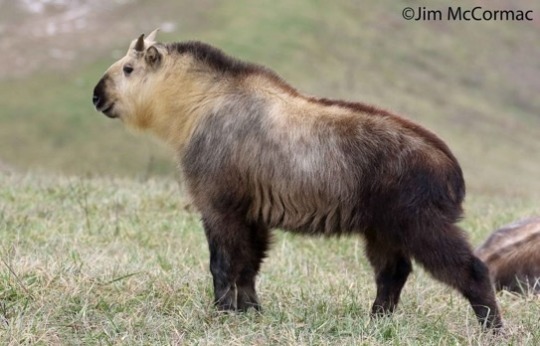
#speculative biology#speculative ecology#speculative evolution#speculative zoology#traditional art#traditional sketch#spectember#paleontology#specposium#fanart#animals#takin#cute animals#paleo meme#paleo#paleoillustration#paleo art#paleontologist#paleoblr#creature#shaggy animal#herbivore#dr. seuss
23K notes
·
View notes
Text
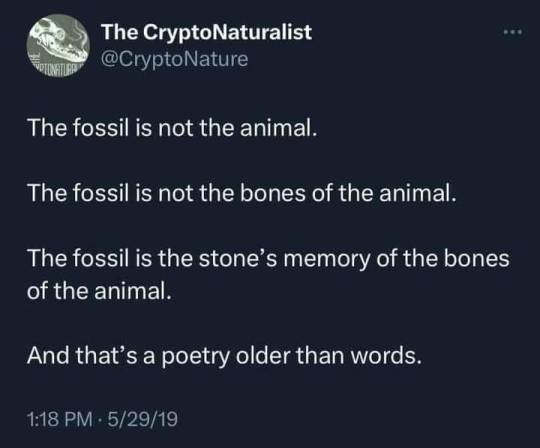
Prehistoric Poetry 🩶🖤🦖🖤🩶
2K notes
·
View notes
Text
Giant tapir.
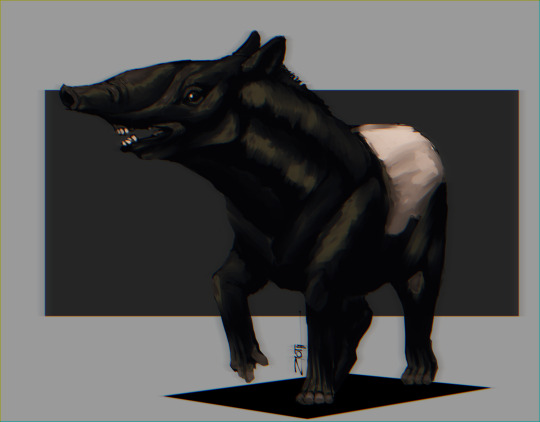
#paleo art#Tapir#Giant tapir#Rare paleo art#Paleontologist#art#artists on tumblr#my art#creature#design#creature design#speculative evolution#spec bio#spec evo#speculative biology#speculative zoology
91 notes
·
View notes
Text

First tyrannosaur fossil discovered with its last meal perfectly preserved in its stomach
Researchers have found a tyrannosaur’s last meal perfectly preserved inside its stomach cavity.
What was on the menu 75 million years ago? The hind legs of two baby dinosaurs, according to new research on the fossil published Friday in the journal Science Advances.
Dinosaur guts and hard evidence of their diets are rarely preserved in the fossil record, and it is the first time the stomach contents of a tyrannosaur have been uncovered.
The revelation makes this discovery particularly exciting, said co-lead author Darla Zelenitsky, a paleontologist and associate professor at the University of Calgary in Alberta.
“Tyrannosaurs are these large predatory species that roamed Alberta, and North America, during the late Cretaceous. These were the iconic apex or top predators that we’ve all seen in movies, books and museums. They walked on two legs (and) had very short arms,” Zelenitsky said.
“It was a cousin of T. rex, which came later in time, 68 to 66 million years ago. T. rex is the biggest of the tyrannosaurs, Gorgosaurus was a little bit smaller, maybe full grown would have been 9, 10 meters (33 feet).”
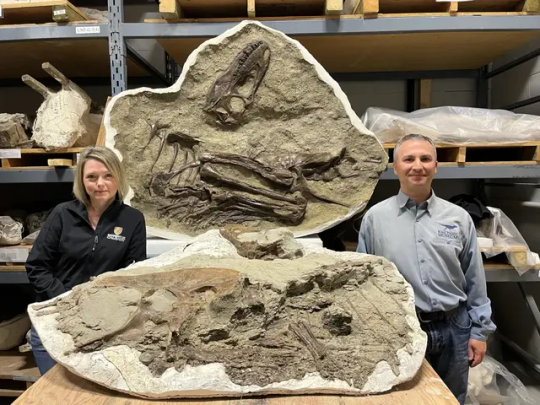
The tyrannosaur in question, a young Gorgosaurus libratus, would have weighed about 772 pounds (350 kilograms) — less than a horse — and reached 13 feet (4 meters) in length at the time of death.
The creature was between the ages of 5 and 7 and appeared to be picky in what it consumed, Zelenitsky said.
“Its last and second-to-last meal were these little birdlike dinosaurs, Citipes, and the tyrannosaur actually only ate the hind limbs of each of these prey items. There’s really no other skeletal remains of these predators within the stomach cavity. It’s just the hind legs.
“It must have killed … both of these Citipes at different times and then ripped off the hind legs and ate those and left the rest of the carcasses,” she added. “Obviously this teenager had an appetite for drumsticks.”

The two baby dinosaurs both belonged to the species called Citipes elegans and would have been younger than 1 year old when the tyrannosaur hunted them down, the researchers determined.
The almost complete skeleton was found in Alberta’s Dinosaur Provincial Park in 2009.
That the tyrannosaur’s stomach contents were preserved wasn’t immediately obvious, but staff at the Royal Tyrrell Museum in Drumheller, Alberta, noticed small protruding bones when preparing the fossil in the lab and removed a rock within its rib cage to take a closer look.
“Lo and behold, the complete hind legs of two baby dinosaurs, both under a year old, were present in its stomach,” said co-lead author François Therrien, the museum’s curator of dinosaur paleoecology, in a statement.
The paleontologists were able to determine the ages of both the predator and its prey by analyzing thin slices sampled from the fossilized bones.
“There’s growth marks like the rings of a tree. And we can essentially tell how old a dinosaur is from looking at those, the structure of the bone,” Zelenitsky said.
Changing appetites of top predators
The fossil is the first hard evidence of a long-suspected dietary pattern among large predatory dinosaurs, said paleoecologist Kat Schroeder, a postdoctoral researcher at Yale University’s department of Earth and planetary science, who wasn’t involved in the research.
The teen tyrannosaur didn’t eat what its parents did. Paleontologists believe its diet would have changed over its life span.
“Large, robust tyrannosaurs like T. rex have bite forces strong enough to hit bone when eating, and so we know they bit into megaherbivores like Triceratops,” Schroeder said via email. “Juvenile tyrannosaurs can’t bite as deep, and therefore don’t leave such feeding traces.”
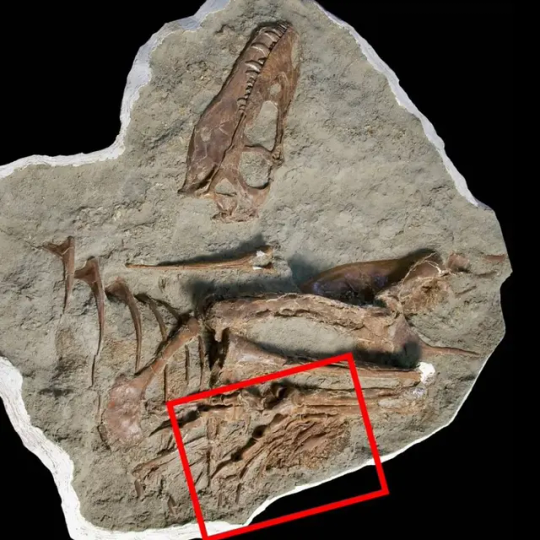
She said that scientists have previously hypothesized that young tyrannosaurs had different diets from fully developed adults, but the fossil find marks the first time researchers have direct evidence.
“Combined with the relative rarity of juvenile tyrannosaur skeletons, this fossil is very significant,” Schroeder added. “Teeth can only tell us so much about the diet of extinct animals, so finding stomach contents is like picking up the proverbial ‘smoking gun.’”
The contents of the tyrannosaur’s stomach cavity revealed that at this stage in life, juveniles were hunting swift, small prey. It was likely because the predator’s body wasn’t yet well-suited for bigger prey, Zelenitsky said.
“It’s well known that tyrannosaurs changed a lot during growth, from slender forms to these robust, bone-crushing dinosaurs, and we know that this change was related to feeding behavior.”
When the dinosaur died, its mass was only 10% of that of an adult Gorgosaurus, she said.
How juvenile tyrannosaurs filled a niche
The voracious appetite of teenage tyrannosaurs and other carnivores has been thought to explain a puzzling feature of dinosaur diversity.
There are relatively few small and midsize dinosaurs in the fossil record, particularly in the Mid- to Late Cretaceous Period — something paleontologists have determined is due to the hunting activities of young tyrannosaurs.
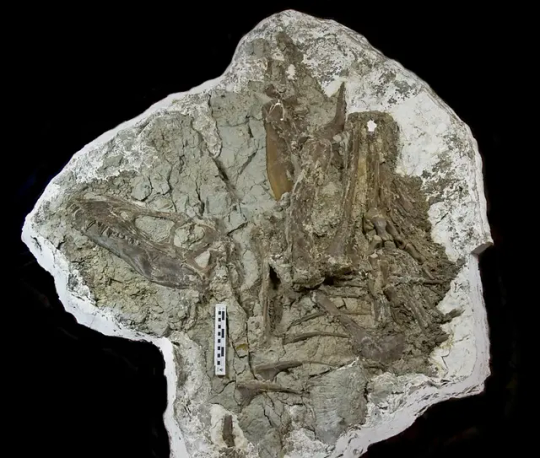
“In Alberta’s Dinosaur Provincial Park, where this specimen is from, we have a very well sampled formation. And so we have a pretty good idea of the ecosystem there. Over 50 species of dinosaurs,” Zelenitsky said.
“We are missing mid-sized … predators from that ecosystem. So yeah, there’s been the hypothesis that, the juvenile tyrannosaurs filled that niche.”
By Katie Hunt.


#First tyrannosaur fossil discovered with its last meal perfectly preserved in its stomach#tyrannosaur#Gorgosaurus libratus#Citipes#Citipes elegans#dinosaurs#paleontologist#Alberta’s Dinosaur Provincial Park#archeology#archeolgst#history#history news#ancient history
77 notes
·
View notes
Text
Opening a Field Jacket...
that's bigger than me can be really hard, especially when said jacket was made in 1966.
This jacket contains the cervical (neck) vertebrae of a dinosaur related to Diplodocus called Barosaurus.
12 notes
·
View notes